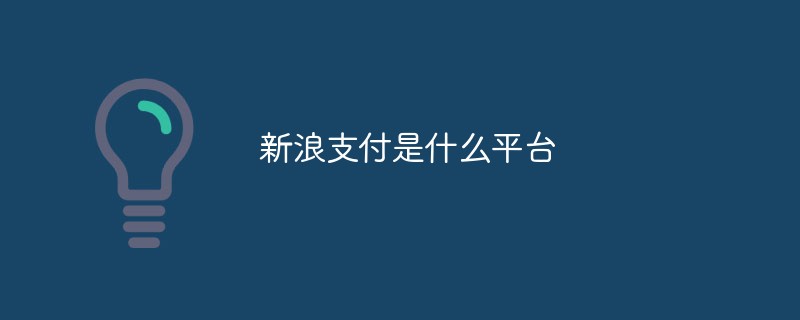Home >Common Problem >What platform is Sina Pay?
What platform is Sina Pay?
- WBOYWBOYWBOYWBOYWBOYWBOYWBOYWBOYWBOYWBOYWBOYWBOYWBOriginal
- 2022-09-15 11:16:0510400browse
Sina Pay is a third-party payment platform; Sina Pay refers to the Weibo wallet, which can directly carry out water and electricity payments, mobile phone recharges and other services in daily life, while third-party payment refers to having certain strength and credibility It is an independent institution that guarantees the online payment model through docking with UnionPay or Netlink to facilitate transactions between the two parties.

The operating environment of this tutorial: Windows 10 system, DELL G3 computer.
What platform is Sina Payment?
Sina Payment is a third-party payment platform.
Sina Payment refers to Weibo Wallet, which is also a third-party payment platform. Using Sina Pay, you can directly conduct daily water and electricity payments, mobile phone recharges, credit card repayments and other services.
A brief introduction to the third-party payment platform
Third-party payment refers to an independent institution with certain strength and credibility guarantee. An online payment model that connects the two parties to facilitate transactions.
In the third-party payment model, after the buyer purchases the goods, he uses the account provided by the third-party platform to pay the payment to the third party, and the third party notifies the seller that the payment has been received and requires delivery; the buyer receives the goods , inspect the goods and confirm, then notify the third party to pay; the third party then transfers the payment to the seller's account.
On the afternoon of January 13, 2017, the People's Bank of China issued a new regulation in the payment field, clarifying that customer reserves generated by third-party payment institutions during the transaction process will be deposited in a unified manner in the future. To a designated account, it is supervised by the central bank, and payment institutions are not allowed to misappropriate or occupy customer reserve funds.
In March 2018, Netlink issued Document No. 42 urging third-party payment institutions to access Netlink channels, clarifying that all direct connections between third-party payment institutions and banks before June 30, 2018 will be blocked. After cutting off, banks will no longer directly provide withholding channels for third-party payment institutions.
Third-party payment adopts payment settlement method.
According to the classification of payment procedures, settlement methods can be divided into one-step payment methods and step-by-step payment methods. The former includes cash settlement, bill settlement such as cheques, cashier's checks, bank drafts, acceptance bills, and remittance settlement such as wire transfers, Online payment, the latter includes letter of credit settlement, letter of guarantee settlement, and third-party payment settlement.
In social and economic activities, settlement belongs to the category of trade.
The core of trade is exchange. Exchange is the unification of the two opposing processes of delivering the object and paying the currency.
Between free and equal normal subjects, the exchange follows the principles of equivalence and synchronization. Synchronous exchange means delivery and payment are mutually conditioned, and is a guarantee of equivalent exchange.
Relevant agreements have been signed between third-party institutions and major banks, allowing third-party institutions and banks to conduct some form of data exchange and related information confirmation.
In this way, third-party institutions can establish a payment process between cardholders or consumers and various banks, as well as the final payee or merchant.
For more related knowledge, please visit the FAQ column!
The above is the detailed content of What platform is Sina Pay?. For more information, please follow other related articles on the PHP Chinese website!

